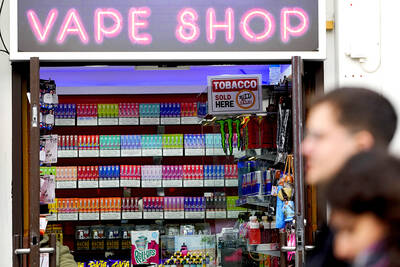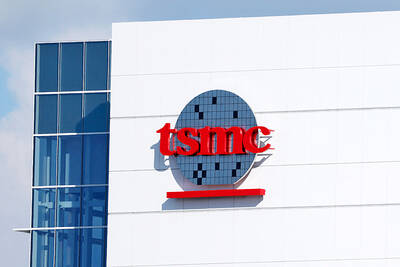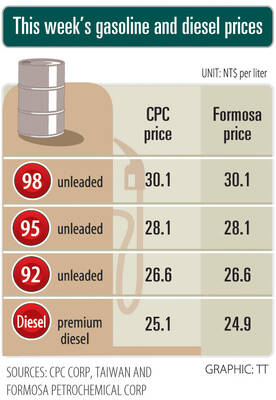At a bustling market on the north side of Moscow, shoppers are upset: After last summer’s devastating fires, staples, such as cabbage and potatoes, are suddenly pricier than the fancy new imported foods.
Booming developing world demand was already pushing up the price of basic food items when Russia was hit by a catastrophic drought that eventually forced the Kremlin to call a halt to all wheat exports last year.
However, the emergency measure provided only temporary relief, with both shoppers and analysts noting an alarming new trend developing on the shelves of stores stretching from Vladivostok in Russia’s Far East to Kaliningrad near Poland.
“Since the summer, potatoes have become unaffordable,” said 30-year-old Maria, a regular shopper at the Moscow market.
Since the middle of December, the price for a kilogram of potatoes has almost doubled from 25 rubles (US$0.85) to more than 40 rubles, leaving many shoppers shaking their heads in dismay.
Staring speculatively at a fruit and vegetable counter, pensioner Maria says she now thinks twice before making a purchase.
“Everything has gone up: sausage, meat, milk ... not to mention vegetables. It is impossible. So now I am buying fewer items,” she said.
Like Maria, many customers have trimmed their shopping lists to the dismay of vendors, who are seeing more of their favorite clients walk out of stores empty-handed.
“The customers I had who were buying two or three cartons of milk are now buying just one,” dairy produce vendor Ruben said.
However, looking at the sticker prices, Ruben admits that he is not terribly surprised.
“On average, a carton that used to cost 30 or 32 rubles two months ago now costs 37 [to] 38 rubles,” Ruben said.
However, forget fancy cheeses and healthy new yogurts. Shoppers say that the price of such basic staples as buckwheat — the simple grain that Russians eat for breakfast, lunch and dinner — has actually tripled since the summer.
Paradoxically to many Russians, a kilogram of bananas is now cheaper in most stores than a sack of potatoes — a fact that has not been lost on the higher ups in the Kremlin.
“A pack of buckwheat cost about 40 rubles last summer. Now, we sell it for 120 rubles,” supermarket assistant Lida said.
Although there are many -factors behind the food inflation, analysts point the primary blame on a record drought that saw harvests fail in 28 Russian regions, slicing 0.5 percent off the country’s GDP.
“There have been several waves of price hikes” in the wake of the weather anomaly, Alfa Bank economist Natalia Orlova said.
“It started with bread and buckwheat, and was followed by milk and now meat,” she said.
Last month alone, the price of an average consumer basket rose by 5.5 percent to 2,769 rubles, according to the Russian Federal State Statistic Service.
The situation is being compounded by accelerating demand in Asia and poor harvests in big crop-producing states — one of the many sparks that set off the recent social unrest in North Africa and the Middle East.
Although Russia is not as sensitive to the price shocks as some of the poorer Arab nations, its prices still move lockstep with those on the global market, Moscow’s Higher School of Economics analyst Sergei Aleksashenko said.
“For cereals, meat, sunflower oil, sugar, milk, Russian prices are fixed according to world prices and their dynamics,” he said.
All the more so because — facing shortages — Russia has been forced to import certain foods.
In December alone, imports of potatoes multiplied tenfold and while those of cabbage rose by 150 percent, official statistics show.
With annual inflation expected to come in at almost 7 percent this year, the authorities are keen to make sure that food prices do not become an issue in December’s parliamentary elections and next year’s presidential poll.

Real estate agent and property developer JSL Construction & Development Co (愛山林) led the average compensation rankings among companies listed on the Taiwan Stock Exchange (TWSE) last year, while contract chipmaker Taiwan Semiconductor Manufacturing Co (TSMC, 台積電) finished 14th. JSL Construction paid its employees total average compensation of NT$4.78 million (US$159,701), down 13.5 percent from a year earlier, but still ahead of the most profitable listed tech giants, including TSMC, TWSE data showed. Last year, the average compensation (which includes salary, overtime, bonuses and allowances) paid by TSMC rose 21.6 percent to reach about NT$3.33 million, lifting its ranking by 10 notches

Popular vape brands such as Geek Bar might get more expensive in the US — if you can find them at all. Shipments of vapes from China to the US ground to a near halt last month from a year ago, official data showed, hit by US President Donald Trump’s tariffs and a crackdown on unauthorized e-cigarettes in the world’s biggest market for smoking alternatives. That includes Geek Bar, a brand of flavored vapes that is not authorized to sell in the US, but which had been widely available due to porous import controls. One retailer, who asked not to be named, because

SEASONAL WEAKNESS: The combined revenue of the top 10 foundries fell 5.4%, but rush orders and China’s subsidies partially offset slowing demand Taiwan Semiconductor Manufacturing Co (TSMC, 台積電) further solidified its dominance in the global wafer foundry business in the first quarter of this year, remaining far ahead of its closest rival, Samsung Electronics Co, TrendForce Corp (集邦科技) said yesterday. TSMC posted US$25.52 billion in sales in the January-to-March period, down 5 percent from the previous quarter, but its market share rose from 67.1 percent the previous quarter to 67.6 percent, TrendForce said in a report. While smartphone-related wafer shipments declined in the first quarter due to seasonal factors, solid demand for artificial intelligence (AI) and high-performance computing (HPC) devices and urgent TV-related orders

Prices of gasoline and diesel products at domestic fuel stations are this week to rise NT$0.2 and NT$0.3 per liter respectively, after international crude oil prices increased last week, CPC Corp, Taiwan (台灣中油) and Formosa Petrochemical Corp (台塑石化) said yesterday. International crude oil prices last week snapped a two-week losing streak as the geopolitical situation between Russia and Ukraine turned increasingly tense, CPC said in a statement. News that some oil production facilities in Alberta, Canada, were shut down due to wildfires and that US-Iran nuclear talks made no progress also helped push oil prices to a significant weekly gain, Formosa said